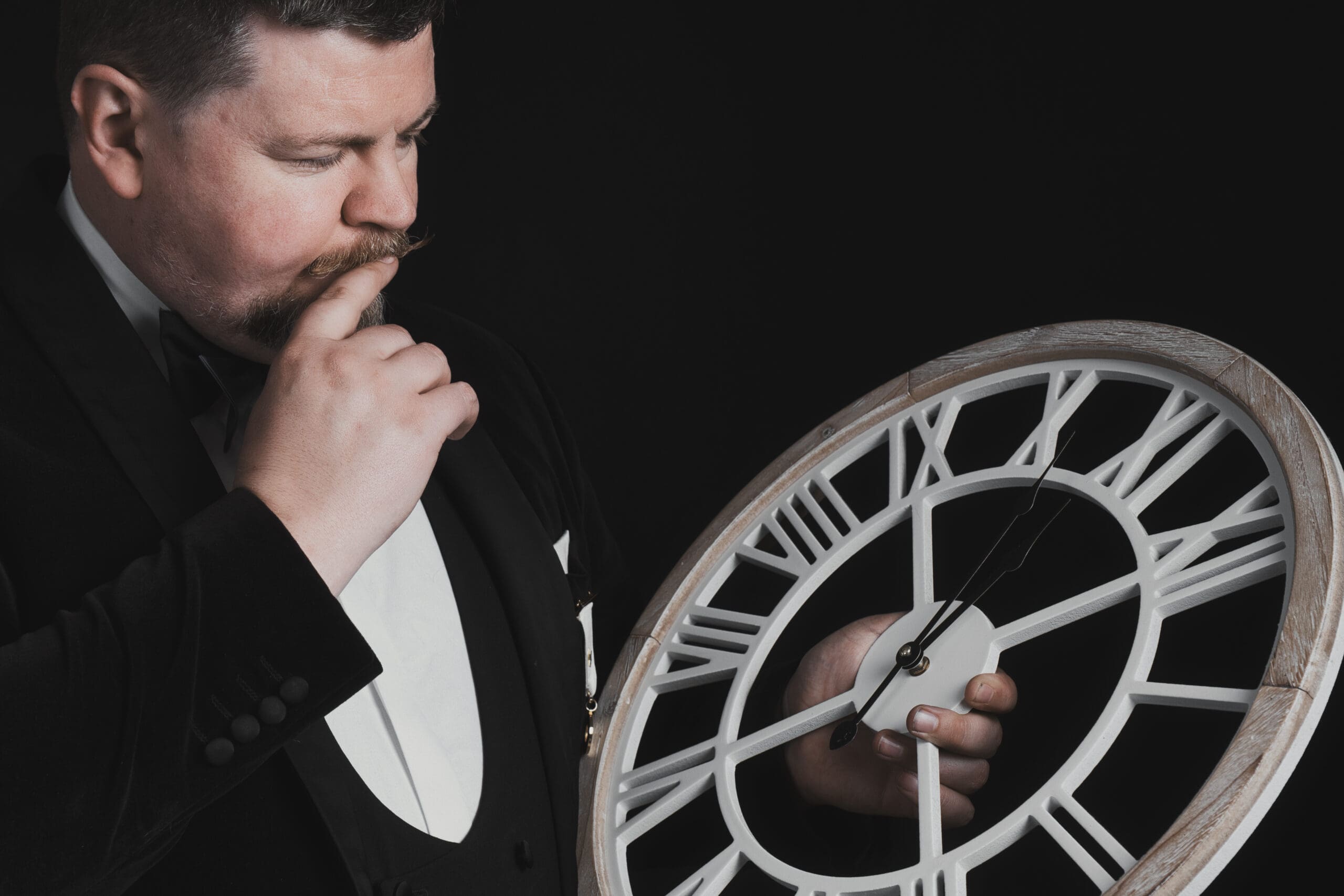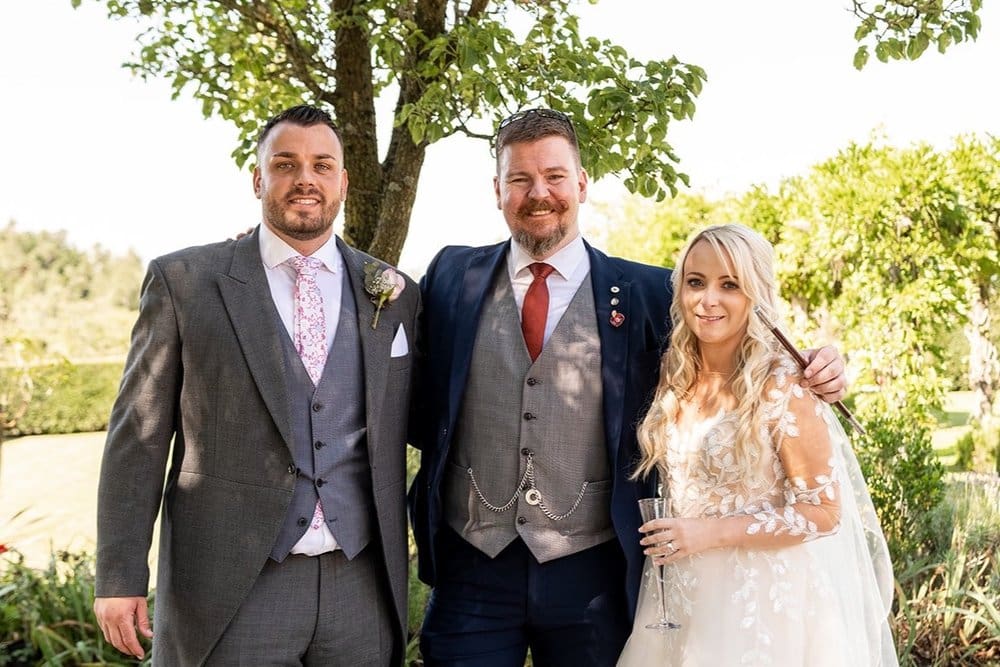A step-by-step guide with a touch of Magic
When you first get engaged, it’s all excitement and magic, just like it should be, but then it finally dawns on you…
You have to plan a wedding.
Planning a wedding when you’ve never done it before (which let’s face it, is most of us) can feel like trying to assemble a grand theatre production… with no script, no director, and a cast of relatives who’ve never rehearsed.
Not only that, but on the day it can sometimes feel like an endurance race for everyone, and you only get one shot to make it perfect.
So let’s demystify it.
I’ve had the privilege of hosting and performing at more weddings than I dare to count, and I’ve seen what makes the day soar — and what causes it to wobble.
So whether you’re deep into planning or just dipping your toes in, here’s a breakdown of what actually happens on the day of the wedding.
What Happens on the Day of the Wedding?
The short answer? A lot.
The longer answer is this: a wedding day is a delicate blend of logistics, emotion, and choreography.
It’s not just about showing up and saying “I do”.
Don’t get me wrong, the I Do’s are pretty important, but it’s about the flow of the day, the energy amongst your guests, and the feeling that every moment is one magicical, seamless, joyful experience.
So, while each and every wedding is unique, the basic structure tends to follow a reasonably familiar path.
What happens at a Wedding – step by step
Here’s a typical breakdown of a basic wedding day timeline, with a touch of refinement:
1. Morning Prep (7am–11am)
Your day will likely begin with hair, makeup, cufflinks, and nerves. Photographers arrive. Champagne may be opened. The couple gets ready – usually separately.
2. Guest Arrival (30–60 minutes before ceremony)
As your guests begin to arrive, they’re greeted, seated, and often unsure of what happens next — unless someone is there to guide them. (This is where your MC starts earning their keep.)
3. The Ceremony (usually 20–45 minutes)
When everyone is in their places, it’s finally time for the moment that everyone’s been waiting for. Music swells and you make your entrances. Vows are spoken, registers signed, and the first official photos are taken. There is probably confetti. Lots and lots of confetti.
4. The Drinks Reception
Whilst you might vanish for some photos, your guests mingle with canapés and bubbles. Here’s where great entertainment and seamless transitions are crucial. without them, it can feel like a bit of a void where your guests are in limbo waiting to see what happens next.
5. The Call to Dinner (and the Grand Entrance)
It’s (finally) time for some food. Guest are asked to take their seats, the scent of delisciousness fills the air, and everyone waits in anticipation for the second time today, whilst you are both announced for your grand entrance as a married couple!
6. The Wedding Breakfast (1.5–2 hours)
This is the sit-down meal — no actual breakfast involved (usually) unless you’re doing something very quirky. But there are usually bubbles and great conversation. After dinner come speeches, laughter, and possibly a few tears.
7. Cake Cutting, First Dance & Evening Guests
As dinner ends, there’s often a brief lull. The cake is cut, the couple dances, and the evening begins. Music kicks in. Lights dim. The day transforms into a party zone where you all dance the night away.
8. Evening Celebrations
This part is more fluid: dancing, drinks, photo booths, surprises. It’s all about having a great time and making greater memories.
What is the 30/5 Minute Rule?
Ok, so planning a day to include all of this, and more, you should consider the 30/5 minute rule.
Assume everything takes 30% longer than expected, and your guests will take 5 minutes longer than you think they will to move anywhere.
Honestly, you will be glad you did.
If you think dinner will take two hours? Budget for two hours and thirty.
Think your guests will move from the bar to the ceremony in ten minutes? Give them fifteen.
Why? Because people — especially in suits and high heels — do not move like stagehands. They chat. They dawdle. They lose Auntie Margaret.
Building in breathing space ensures the day feels relaxed, not rushed. And trust me, the difference is real magic.


With all of this to consider, what is the most important part of a Wedding Day?
Now this probably sounds like a trick question. It’s the ceremony, surely?
The vows?
The kiss?
Well technically, yes. But the most important part is something much more subtle, a crucially important details which is often forgotten about:
The feeling that the day is flowing effortlessly, and everyone knows what’s happening, when, and why.
Because that’s what makes your guests relax.
That’s what lets you both be present at YOUR Wedding day, and not running off somewhere every 10 minutes playing Project Manager.
And, that’s what creates those magical, memorable moments that people never forget and talk about for years.
Need Help Planning the Day? Start Here.
The truth is, planning a wedding can feel really overwhelming. It’s an important day and you (naturally) want to get it right.
To help you to do that, I’ve created a free wedding planning course and a suite of planning resources to help you build your timeline, avoid the usual pitfalls, and enjoy the process.
It’s a short series of short videos that you can watch which will help you to better understand how to plan your dream wedding day. You’ll find it all here:
👉 www.yourmagicalweddinghost.com/resources
Planning a wedding doesn’t have to feel like spinning 100 plates while riding a horse backwads and being blindfolded. With the right guidance, and a touch of Gentlemanly magic, it can be smooth, joyful, and unforgettable.
Because while love is at the heart of the day — timing is what makes it sing.
That’s got to be worth checking out then… right?
